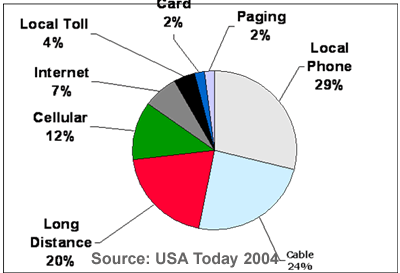Verizon Fiber Optic Television
I used to go to engineering conferences even though I'm a social scientist. I have to get back to going. Something about having children made going hither and yon (or thither, your choice). The beauty of these conferences is that they talk about technologies that are literally in the lab or even in test phases. The telcos (for "telephone companies" which made cable companies decide they were "cablecos) have been gearing up for video for 20+ years (certainly 15) based on my experience.
Not to be a commercial for Verizon, but doesn't this look like a cable company ad?
* 100% fiber optic network
* On Demand - Instant access to a library of the latest blockbuster movies, kids shows, sports programs and much more at a touch of a button.
* HD channels - More of a selection to watch all your favorite channels like ESPN, Discovery, TNT and more - all in amazing high definition.
* Picture and sound - Amazingly lifelike picture, hyper-real color and flawless sound.
* Dual-tuner DVR - Gives you the freedom to pause and rewind live TV, record one show while watching another, and fast forward to your favorite part.
* Top premium channels - When you subscribe to one of our premium services like HBO and Cinemax you can select from current favorites to original programming, 24 hours a day.
* International channels - Stay connected to your homeland or the world with more than a dozen popular international premium channels including, RAI (Italian), TV5 (French), ART (Arabic), TV Japan (Japanese). This is a diagram that I often saw at these conferences, only this one is current whereas the others were "the future". Funny how the telco video future seemed to be 2-3 years away no matter when I attended a conference.
This is a diagram that I often saw at these conferences, only this one is current whereas the others were "the future". Funny how the telco video future seemed to be 2-3 years away no matter when I attended a conference.
 Why would a telco want to get into the video business? Well, this slide from a National Telecommunications Cooperative presentation in 2004 shows how cable TV was taking a large slice out of the (rural, no less) telco revenue pie. The presentation (accessed 22 September 2006) literally tells audience members to fight cable by grabbing some of cable's video revenues.
Why would a telco want to get into the video business? Well, this slide from a National Telecommunications Cooperative presentation in 2004 shows how cable TV was taking a large slice out of the (rural, no less) telco revenue pie. The presentation (accessed 22 September 2006) literally tells audience members to fight cable by grabbing some of cable's video revenues.
So, today's lesson is that there is more competition for the trible play: voice (POTS, plain old telephone service), video (cable, historically) and data (Internet, companies like Earthlink and AOL). This is good news for consumers until and unless these companies continue to merge, reducing the competition. Don't forget those two satellite providers, either. They help by trying to beat one another and cable TV!
You may use this content (better still, argue with me!), but please cite my ideas as © 2006, Dr. Bruce Klopfenstein. Find any typos! Don't smite me, let me know!
 Thanks blogger community for solving my mysterious error. I'll hang on to
Thanks blogger community for solving my mysterious error. I'll hang on to 


